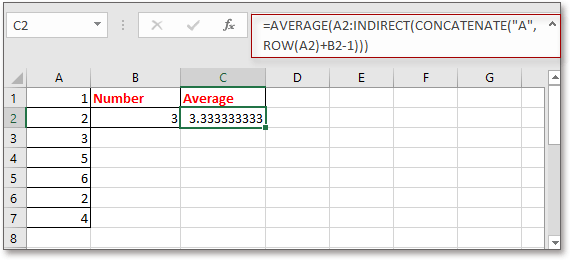Hoe een bereik te definiëren op basis van een andere celwaarde in Excel?
Het berekenen van een bereik met waarden is eenvoudig voor de meeste Excel-gebruikers, maar heb je ooit geprobeerd om een bereik van waarden te berekenen op basis van het getal in een specifieke cel? Bijvoorbeeld, er is een kolom met waarden in kolom A, en ik wil het aantal waarden in kolom A berekenen op basis van de waarde in B2. Dit betekent dat als het 4 is in B2, ik het gemiddelde van de eerste 4 waarden in kolom A zal berekenen zoals in onderstaande schermafbeelding te zien is. Nu introduceer ik een eenvoudige formule om snel een bereik te definiëren op basis van een andere celwaarde in Excel.
Bereik definiëren op basis van celwaarde
 Bereik definiëren op basis van celwaarde
Bereik definiëren op basis van celwaarde
Om een berekening uit te voeren voor een bereik op basis van een andere celwaarde, kunt u een eenvoudige formule gebruiken.
Selecteer een lege cel waarin u het resultaat wilt weergeven en voer deze formule in =GEMIDDELDE(A1:INDIRECT(TEKST.SAMENVOEGEN("A";B2))), en druk op Enter om het resultaat te krijgen.
1. In de formule is A1 de eerste cel in de kolom die u wilt berekenen, A is de kolom waarvoor u berekent, en B2 is de cel waarop u de berekening baseert. U kunt deze verwijzingen naar behoefte wijzigen.
2. Als u een totaal wilt berekenen, kunt u deze formule gebruiken =SOM(A1:INDIRECT(TEKST.SAMENVOEGEN("A";B2))).
3. Als de eerste gegevens die u wilt definiëren niet in de eerste rij van Excel staan, bijvoorbeeld in cel A2, kunt u de volgende formule gebruiken: =GEMIDDELDE(A2:INDIRECT(TEKST.SAMENVOEGEN("A";RIJ(A2)+B2-1))).
Snel cellen tellen/optellen op basis van achtergrond- of opmaakkleur in Excel |
In sommige gevallen heb je mogelijk een bereik met cellen in meerdere kleuren, en wil je waarden optellen of tellen op basis van dezelfde kleur. Hoe kun je dit snel berekenen? Met Kutools voor Excel'sTellen op kleur, kun je snel veel berekeningen uitvoeren op basis van kleur en ook een rapport genereren van de berekende resultaten. Download Kutools en probeer het vandaag nog! |
Kutools voor Excel - Boost Excel met meer dan 300 essentiële tools. Geniet van permanent gratis AI-functies! Nu verkrijgen |
Beste productiviteitstools voor Office
Verbeter je Excel-vaardigheden met Kutools voor Excel en ervaar ongeëvenaarde efficiëntie. Kutools voor Excel biedt meer dan300 geavanceerde functies om je productiviteit te verhogen en tijd te besparen. Klik hier om de functie te kiezen die je het meest nodig hebt...
Office Tab brengt een tabbladinterface naar Office en maakt je werk veel eenvoudiger
- Activeer tabbladbewerking en -lezen in Word, Excel, PowerPoint, Publisher, Access, Visio en Project.
- Open en maak meerdere documenten in nieuwe tabbladen van hetzelfde venster, in plaats van in nieuwe vensters.
- Verhoog je productiviteit met50% en bespaar dagelijks honderden muisklikken!
Alle Kutools-invoegtoepassingen. Eén installatieprogramma
Kutools for Office-suite bundelt invoegtoepassingen voor Excel, Word, Outlook & PowerPoint plus Office Tab Pro, ideaal voor teams die werken met Office-toepassingen.
- Alles-in-één suite — invoegtoepassingen voor Excel, Word, Outlook & PowerPoint + Office Tab Pro
- Eén installatieprogramma, één licentie — in enkele minuten geïnstalleerd (MSI-ready)
- Werkt beter samen — gestroomlijnde productiviteit over meerdere Office-toepassingen
- 30 dagen volledige proef — geen registratie, geen creditcard nodig
- Beste prijs — bespaar ten opzichte van losse aanschaf van invoegtoepassingen